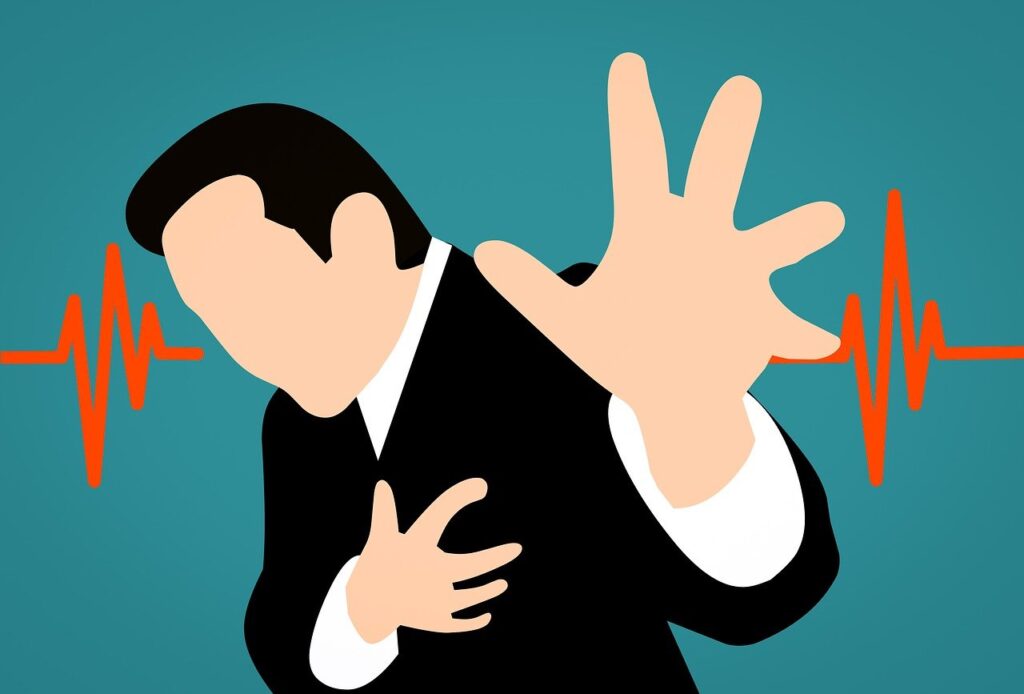Pain when taking deep breaths, also known as pleuritic chest pain, can be a serious and uncomfortable symptom that you may experience. Let me explore the various causes, symptoms, and potential treatments when it hurts to take a deep breath.
Why Does it Hurt When I Take Deep Breaths?
There are many reasons why you may experience chest pain when taking deep breaths. Some of the well-known causes include:
- Pleurisy: This is a condition caused by inflammation of the lining of your lungs and chest (pleura) that can cause a sharp pain when you are breathing. It’s often associated with infections like pneumonia.
- Costochondritis: Inflammation of your cartilage that connects the ribs to the breastbone can result in you having localized chest pain and it hurts to take a deep breath.
- Muscle Strain: Overexertion or injury to your chest or back muscles can lead to pain during deep breaths.
- Rib Fractures: A fracture in one of your ribs can cause sharp pain with every breath that you take.
- Pulmonary Embolism: A blood clot in your lungs can lead to severe chest pain and difficulty in your breathing.
- Gastroesophageal Reflux Disease (GERD): When stomach acid flows back into your esophagus, it can cause heartburn and chest pain.
- Lung Infections: Conditions like bronchitis or pneumonia can result in chest discomfort during breathing.
Symptoms of Pain When Taking Deep Breaths
Symptoms you may experience when it hurts to take a deep breath may vary depending on the underlying cause, but common signs include:
- Having a sharp or stabbing chest pain
- Experiencing Increased pain with deep breaths or coughing
- Having Difficulty taking deep breaths
- Getting Pain that may radiate to the back or shoulders
- Tenderness or discomfort in your chest area
Variations of Pain When Taking Deep Breaths
Deep breath Pain on the Left Side
One patient asks “Why does it hurt when I take a deep breath on my left side?”
Well here are some possible reasons for this type of pain:
- Muscular strain: Overuse or strain of the muscles in the chest, ribcage, or upper back can cause pain, especially when taking deep breaths.
- Costochondritis: Costochondritis is an inflammation of the cartilage that connects your ribs to the breastbone (sternum). This condition can result in chest pain, which may be worsened by deep breathing.
- Pleuritis: Pleuritis, also known as pleurisy, is an inflammation of the lining surrounding the lungs. It can cause sharp or stabbing pain when breathing, particularly during deep breaths.
- Pneumonia: Lung infections like pneumonia can cause pain on one side of the chest when breathing deeply. Other symptoms typically include cough, fever, and chest pain accompanied by difficulty breathing.
- Rib fractures or injuries: Trauma to the ribs or rib fractures can result in pain during deep breaths, especially when the affected area is involved.
- Pulmonary embolism: A pulmonary embolism occurs when a blood clot blocks a blood vessel in the lungs. This can cause chest pain, shortness of breath, and difficulty breathing.
- Heart-related issues: While less common, certain heart conditions, such as angina or pericarditis, can cause chest pain that may be felt more on one side.
- Gastroesophageal reflux disease (GERD): Acid reflux can lead to heartburn and chest discomfort, which may worsen with deep breathing.
- Other medical conditions: Various other conditions, such as pleural effusion, pneumothorax (collapsed lung), or even issues with nearby organs like the spleen or stomach, could potentially cause chest pain on one side when taking deep breaths.
Deep Breath Pain on the Right Side
Another patient asks, “Why does it hurt when I take a deep breath on my right side?” Well
Here are some possible reasons for experiencing pain on the right side when breathing deeply:
- Muscular strain: Overexertion, muscle strain, or injury to the muscles in the chest, back, or ribcage can result in pain, especially when taking deep breaths.
- Costochondritis: Inflammation of the cartilage that connects the ribs to the breastbone (sternum) can lead to chest pain, which may be aggravated by deep breathing.
- Pleuritis or pleurisy: Inflammation of the pleura, the lining around the lungs, can cause sharp or stabbing pain when breathing deeply.
- Gallbladder issues: Problems with the gallbladder, such as gallstones or inflammation, can sometimes cause referred pain in the right upper chest or shoulder area.
- Liver issues: Conditions affecting the liver, like hepatitis or liver congestion, may lead to discomfort or pain in the right upper abdomen that can be felt in the chest area.
- Pneumonia: Lung infections like pneumonia can cause pain on one side of the chest, particularly when taking deep breaths. Other common symptoms include cough, fever, and difficulty breathing.
- Rib fractures or injuries: Trauma or injuries to the ribs, such as fractures, can result in pain when breathing, especially if the injured area is on the right side.
- Pulmonary embolism: A pulmonary embolism occurs when a blood clot obstructs a blood vessel in the lungs, which can cause chest pain, shortness of breath, and pain when taking deep breaths.
- Gastroesophageal reflux disease (GERD): Acid reflux can lead to heartburn and chest discomfort, which may worsen with deep breathing.
- Other medical conditions: Various other conditions, such as pleural effusion, pneumothorax (collapsed lung), or issues with nearby organs like the gallbladder or the stomach, could potentially cause right-sided chest pain when breathing deeply.
Female Chest Pain on Left Side When Breathing

Here are some special causes of left-sided chest pain in females when breathing:
- Breast-related issues: Breast pain: Pain or discomfort in the left breast can sometimes be felt more acutely during deep breaths. This could be due to hormonal changes or benign breast conditions.
- Mastitis: An infection or inflammation of the breast tissue can cause chest pain on the left side and is often accompanied by redness, warmth, and tenderness in the affected breast.
- Hormonal factors: Menstrual cycle: Some women may experience chest pain or breast tenderness as a part of premenstrual syndrome (PMS) or due to hormonal fluctuations during their menstrual cycle.
- Cardiovascular issues: Angina: While angina can affect both men and women, the symptoms may be different in women. Chest pain on the left side during deep breaths could be related to angina, which is chest pain caused by reduced blood flow to the heart muscle.
- Pulmonary embolism: Pulmonary embolism, a blood clot in the lung, can affect both men and women. It’s more common in women, particularly during pregnancy and the postpartum period. Chest pain on the left side when breathing deeply can be a symptom of this serious condition.
- Pleuritis or pleurisy: Inflammation of the pleura, the lining around the lungs, can cause sharp or stabbing pain when breathing deeply, and this can affect both men and women.
- Gastroesophageal reflux disease (GERD): Acid reflux can lead to heartburn and chest discomfort, which may be felt on the left side and can worsen when taking deep breaths. Hormonal changes can sometimes exacerbate GERD symptoms in women.
- Pericarditis: Inflammation of the pericardium, the lining around the heart, can cause chest pain, which may be felt on the left side and is often aggravated by deep breathing.
- Anxiety and stress: Anxiety can cause chest pain, and women may be more prone to anxiety-related chest pain, especially during times of hormonal changes, such as menopause.
Diagnosis of Pain When Taking Deep Breaths
To determine the exact cause of your pain when taking deep breaths, your healthcare provider will recommend the following:
- Physical Examination: Checking for tenderness or signs of injury in your chest area.
- Imaging: X-rays, CT scans, or MRIs can provide detailed images of your chest and help him or her identify structural issues.
- Blood Tests: To check for signs of infection or other medical conditions you may have.
- ECG (Electrocardiogram): To rule out any heart-related issues.
Treatment of Pain When Taking Deep Breaths
The treatment of pain when taking deep breaths depends on the underlying cause:
- Infections: Antibiotics may be prescribed for bacterial infections, and antiviral medications can help with viral infections.
- Pain Management: Over-the-counter pain relievers like ibuprofen or acetaminophen can provide relief.
- Anti-Inflammatory Medications: For conditions like pleurisy or costochondritis, nonsteroidal anti-inflammatory drugs (NSAIDs) may be recommended.
- Relaxation: Resting and avoiding activities that worsen the pain can aid in your recovery.
- Treatment of Underlying Conditions: Managing conditions like GERD or pulmonary embolism is crucial to relieving chest pain.
- Physical Therapy: If the pain is due to muscle strain or injury, physical therapy can help.
Prevention of Pain When Taking Deep Breaths
Preventing pain when taking deep breaths largely depends on the underlying cause. However, maintaining good overall health, practicing proper posture, and taking precautions during physical activities can reduce your risk of developing chest injuries and related pain.
Pain when taking deep breaths can be a symptom of various underlying conditions, some of which may require prompt medical attention. If you experience persistent or severe chest pain when breathing deeply, it is essential to consult with a healthcare provider for a proper diagnosis and appropriate treatment. Early intervention can help manage the pain and prevent potential complications.
What Should I Do When It Hurts to Take a Deep Breath?
Experiencing pain when taking a deep breath can be concerning and may indicate various underlying conditions, including respiratory or cardiac issues. Here are some steps you can take:
- Stop and Rest: If you’re experiencing pain when breathing deeply, pause and try to rest in a comfortable position.
- Seek Medical Attention: If the pain persists or worsens, especially if it’s accompanied by other symptoms such as chest pain, shortness of breath, fever, or coughing up blood, seek medical attention immediately. Call emergency services or visit the nearest emergency department.
- Avoid Physical Exertion: Try to avoid activities that exacerbate the pain, such as strenuous exercise.
- Stay Calm: It’s natural to feel anxious when experiencing pain, but staying calm can help you think clearly and make appropriate decisions.
- Follow Medical Advice: Once you seek medical attention, follow the advice and treatment plan provided by your healthcare provider. They will assess your condition, perform any necessary tests, and recommend appropriate treatment based on the underlying cause of your symptoms.
- Medication: If the pain is related to a specific condition such as inflammation or infection, your healthcare provider may prescribe medication to help alleviate the pain and treat the underlying cause.
- Monitor Symptoms: Keep track of any changes in your symptoms, and report them to your healthcare provider. This information can help them adjust your treatment plan as needed.
Explore www.medicalantidote.com for in-depth health articles.


